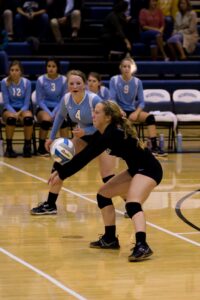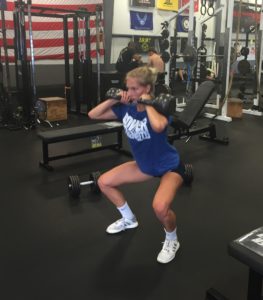6 Training Principals Every Volleyball Player Must Follow
This is part 1 of a 2 part series.
We have been fortunate to work with many dedicated female athletes over the years here at PowerStrength. From middle school athletes to college athletes to entire college teams – we’re constantly trying to improve our methods for our girls. Volleyball athletes, in particular, have sought us out more than any other female sport. We have two great guesses to why this is – #1 these girls want to train around other serious athletes, and #2, the demands of their sport greatly require consistent, planned off-season training.
Our experience has revealed that many girls are not training at all, or their training could use a few tweaks. Actually, that is putting it too nicely. The number of female athletes who truly commit themselves to a consistent, strength and development program is criminally low!
Interested in training?
Is it time for your athlete to follow a progressive plan?
Want to improve jumping ability, strength, and reduce the number of preventable injuries?
Good. We want to help.
We compiled a list of our Top 6 principles we follow when training our volleyball athletes. Naturally this is not a complete list, but use it to provide the necessary criteria to add to your training program:
- Land Before You Jump
All volleyball players want to increase their vertical jump. All of them are tested on their approach jump or their ability to play above the net. Training for power and a higher vertical is definitely necessary, our main focus early is on the brakes, not the gas. Why?
First, volleyball athletes have an incredible volume of jumps during their practice and games so they must learn how to land from this high volume – if not, they will consistently do it wrong.
Secondly, we all know that female athletes are at a greater risk for ACL and knee injuries – upwards of 7x more likely compared to males some research shows. Teaching them to accept force in their landing, get to good body positions, and maintain good positions will drastically reduce the likelihood of injury. This also ensures that they aren’t simply practicing, and playing, themselves into decreased performance due to improper landing mechanics. You would never get in a plane if the pilot didn’t know how to land it, so the athlete should learn how to safely handle the extra forces before they train to jump higher. A proper landing will provide the energy for a more powerful takeoff.
- Train Short Sprints and Change of Direction
The next skill that all volleyball players need to focus on is everything between the jumps. Getting to the ball more efficiently, retreating quicker to set up defense, and most importantly, learning to recover from mistakes and bad reads – are very valuable skills that must be addressed more frequently in training.
You can accomplish this in a number of ways. Begin with these 3.
Start in multiple positions
The athlete can start each drill either standing, kneeling, on your belly, on your back, etc. This conditions them to not get too comfortable in one perfect position and teaches them many different to accelerate.
Always respond to a cue
This can be a verbal, visual, or cognitive cue. The goal is to train your ability to react. Training your ability to react to many different stimuli enhances your physical ability to react to a ball and the flow of the game much easier (not taking volleyball IQ into account).
Train deceleration.
Changing directions efficiently begins with the ability to decelerate. Just like with landing, learning how to decelerate and regaining good position will help develop more speed/power in the desired direction. Think about it, in the flow of a game, every change of direction is preceded by a deceleration. In addition, deceleration is the second mechanism (contact is first) by which injury is most likely to occur so it’s imperative athletes can do it very well.
- Learn to Create Tension First
Volleyball is unique in that much of the hitting that occurs is off the ground. Unlike many other sports where the athlete is planted, hitting in the air doesn’t allow you to use the ground to create tension and force. This disconnected hitting (hitting in the air) creates a challenge for girls who can’t create tension within their frame and use contralateral (opposite side) forces to oppose their swing.
It may sound easy, but learning how to create tension is often more challenging than you would think. Here’s how we do it:
- Teach correct breathing and bracing
- Use ground-based crawls to teach full body tension
- Provide and progress resistance within controlled movements (exercises)
- Constantly cue bracing, position, and torque in all lifting movements.
- As they progress further we use various jumps, medicine ball throws, and Olympic lift variations to teach them to brace effectively as they put out more power and the speed of the movement increases.
We start with the big picture of full body tension then fix issues at the more specific level as they present themselves. Many coaches do the opposite where they try to train the hips or shoulder individually with the hope of it improving functionality as a whole. However, if the shoulder is always in a bad position and unbraced as you move, no amount of strength in the rotator cuff or soft tissues will be enough to prevent injury in the long run.
Next week we will post part 2 and the remaining 3 training principles. Stay tuned!
“I cannot express in words how thankful I am for this program and for all of the PSTS staff. They have impacted my life so much more than I ever thought it would. I’ve become the athlete that I always wanted to be. The principles and values PSTS embodies carries over to my every day life. I’m so thankful for them pushing me to be a better athlete and better person. PowerStrength has helped me out tremendously and it was one of my best decisions ever to start training here. I know I will always have another family here.” – Samantha M. – Division 1 College Volleyball
If you found this article helpful and you would like to learn more about training in our program, click HERE to claim your free workout and consultation! Tell us how we can help you with your training and goals to make you a better athlete on the court.


